Welcome to MyGardensBloom.com! Today, we’re excited to introduce you to the charming and vibrant larkspur flowers. These stunning blooms, known for their tall, spiky clusters of flowers in shades of blue, pink, white, and purple, can add a splash of color and elegance to any garden. Whether you’re an experienced gardener or a novice, larkspur is a fantastic addition to your floral lineup. Let’s dive into how to grow and care for these captivating flowers.
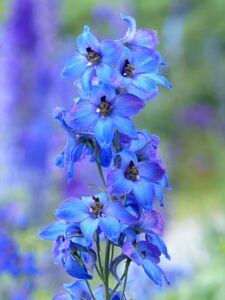
The Allure of Larkspur Flowers
Larkspur, scientifically known as Delphinium, is a popular annual or perennial flower that is part of the Ranunculaceae family. The name “larkspur” comes from the flower’s resemblance to a lark’s spur, a bird known for its distinctive foot shape. These flowers are not only visually stunning but also beloved by pollinators, making them a great choice for eco-friendly gardening.
Choosing the Right Variety
There are numerous species and hybrids of larkspur, each offering unique characteristics. Here are some popular varieties:
Consolida ajacis (Rocket Larkspur): An annual variety known for its tall, feathery flower spikes and a wide range of colors.
Delphinium elatum (Pacific Giant Hybrid): A perennial variety with tall, robust stems and large, densely packed flowers.
Delphinium grandiflorum (Chinese Larkspur): A shorter perennial with delicate, finely cut foliage and vibrant blue flowers.
Choose the variety that best fits your garden’s needs and aesthetic preferences.
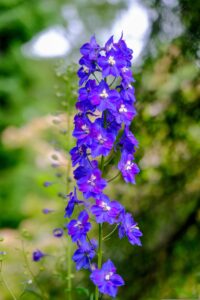
Planting Larkspur Flowers
When to Plant
Larkspur seeds can be planted in the fall for early spring blooms or in the early spring after the last frost. If you’re planting transplants, wait until all danger of frost has passed.
Soil and Location
Larkspurs prefer well-drained soil rich in organic matter. They thrive in full sun but can tolerate light shade, especially in hotter climates.
Soil Preparation
Work compost or well-rotted manure into the soil to improve fertility and drainage. Larkspur prefers slightly alkaline to neutral soil (pH 6.5-7.5).
Planting Location
Choose a spot that receives at least 6 hours of direct sunlight daily. In hotter regions, a location with afternoon shade can help protect the plants from intense heat.
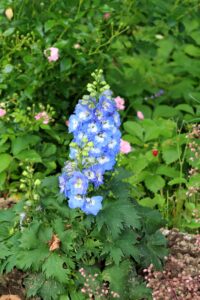
Planting Seeds or Transplants
From Seeds: Sow larkspur seeds directly into the garden bed. Scatter the seeds on the soil surface and lightly cover them with a thin layer of soil. Keep the soil consistently moist until germination, which usually occurs within 2-3 weeks.
From Transplants: Space the young plants about 12-18 inches apart to allow for adequate air circulation and growth.
Caring for Larkspur Flowers
Watering
Larkspur needs regular watering, especially during dry periods. Water deeply once or twice a week, depending on weather conditions, ensuring the soil remains consistently moist but not waterlogged.
Fertilization
Feed larkspur with a balanced, all-purpose fertilizer in early spring when new growth begins and again in mid-summer. Avoid high-nitrogen fertilizers, as these can promote excessive foliage growth at the expense of flowers.
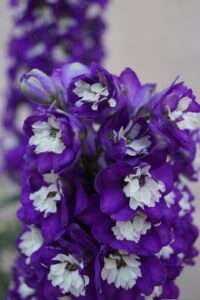
Pruning and Deadheading
Deadhead spent blooms to encourage continuous flowering and to prevent self-seeding if you don’t want larkspur to spread. Cut back the stems to a healthy leaf node after the flowers fade.
Staking
Tall varieties of larkspur flowers may require staking to support their heavy flower spikes, especially in windy conditions. Use bamboo stakes or garden twine to gently tie the stems.
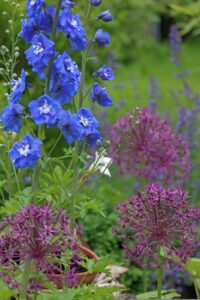
Pests and Diseases
Larkspur flower is relatively disease-resistant but can be susceptible to powdery mildew, rust, and fungal leaf spots. Ensure good air circulation and avoid overhead watering to minimize these issues. Watch for common pests like aphids and slugs, treating them with insecticidal soap or organic slug pellets as needed.
Enjoying Larkspur in Your Garden
Larkspur’s tall, colorful spikes make a stunning addition to garden borders, cutting gardens, and mixed flower beds. They pair beautifully with other tall perennials like foxgloves, hollyhocks, and sunflowers. Additionally, larkspur flowers are excellent for cutting and using in fresh or dried arrangements, adding a touch of elegance to indoor decor.
Toxicity Warning
It’s important to note that all parts of the larkspur plant are toxic if ingested. Keep these flowers out of reach of children and pets, and always wear gloves when handling them to avoid skin irritation.
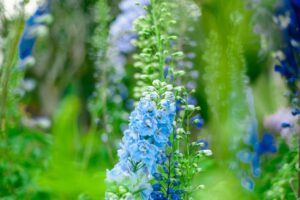
Growing larkspur flowers can transform your garden into a vibrant, pollinator-friendly paradise. With their striking colors and towering presence, larkspurs are sure to become a favorite in your floral collection. By following these simple planting and care tips, you’ll enjoy a bountiful display of these enchanting blooms season after season.
Thank you for joining us on this gardening journey! For more tips, tricks, and inspiration, stay tuned to MyGardensBloom.com. Happy gardening! If you have any questions or want to share your larkspur growing experiences, leave a comment below. We’d love to hear from you!


